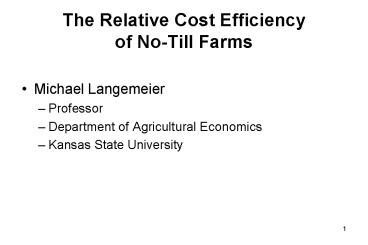The Relative Cost Efficiency of No-Till Farms - PowerPoint PPT Presentation
1 / 11
Title:
The Relative Cost Efficiency of No-Till Farms
Description:
Note: Technical Efficiency was not significantly different between the two groups of farms. ... utilization. Management. Farm Size. 10. Contact Information ... – PowerPoint PPT presentation
Number of Views:42
Avg rating:3.0/5.0
Title: The Relative Cost Efficiency of No-Till Farms
1
The Relative Cost Efficiencyof No-Till Farms
- Michael Langemeier
- Professor
- Department of Agricultural Economics
- Kansas State University
2
Objectives and Data
- Examine the relative efficiency of no-till farms
in central Kansas. - Kansas Farm Management Association (KFMA ) Data
- Continuous data from 2003 to 2007
- To be designated as a no-till farm, a farm had to
utilize a no-till production system for all of
their crops - Farms categorized into two groups
- No-till (73 farms)
- Reduced or conventional tillage (239 farms)
3
Kansas Farm Management Associations
4
Definitions
- Value of Farm Production
- Sum of livestock, crop, and other income computed
on an accrual basis minus accrual feed purchased. - Net Farm Income
- Return to operators labor, management, and
equity (net worth) computed on an accrual basis. - Less Tillage Index
- Computed by dividing herbicide and insecticide
cost by total crop machinery cost which includes
repairs, fuel, auto expense, machinery and
equipment depreciation, crop machine hire, and an
opportunity interest charge on crop machinery and
equipment investment.
5
Definitions
- Profit Margin
- Computed by dividing net farm income plus cash
interest paid minus opportunity charges on
operator and family labor by value of farm
production. - Asset Turnover Ratio
- Computed by dividing value of farm production by
total farm assets. - Technical Efficiency Index (ranges from 0 to 1)
- Farms with an index of 1 are using the best
available technologies and producing on the
production frontier. - Cost Efficiency Index (ranges from 0 to 1)
- Farms with an index of 1 are producing at the
lowest cost per unit of aggregate output.
6
Comparison of Tillage andNo-Till Farms, Central
Kansas
Farm Characteristics No-Till Mixed Tillage
Value of Farm Production 360,109 266,618
Net Farm Income 74,432 53,114
Total Hectares 817 699
Less Tillage Index 0.162 0.110
7
Comparison of Tillage andNo-Till Farms, Central
Kansas
Financial Ratios and Efficiency No-Till Mixed Tillage
Profit Margin 0.1256 0.0881
Asset Turnover Ratio 0.3729 0.3011
Cost Efficiency 0.664 0.611
Note Technical Efficiency was not significantly different between the two groups of farms. Note Technical Efficiency was not significantly different between the two groups of farms. Note Technical Efficiency was not significantly different between the two groups of farms.
8
Comparison of Tillage andNo-Till Farms, Central
Kansas
Income Shares No-Till Mixed Tillage
Feed Grains 0.2125 0.1683
Oilseeds 0.1440 0.0914
Small Grains 0.2277 0.2959
There was not a significant difference between hay and forage, beef, or dairy income shares. There was not a significant difference between hay and forage, beef, or dairy income shares. There was not a significant difference between hay and forage, beef, or dairy income shares.
9
Comparison of Tillage andNo-Till Farms, Central
Kansas
Cost Shares No-Till Mixed Tillage
Labor 0.1904 0.2577
Seed 0.0658 0.0570
Chemicals 0.0823 0.0575
Capital 0.5860 0.7035
There was not a significant difference between livestock and fertilizer cost shares. There was not a significant difference between livestock and fertilizer cost shares. There was not a significant difference between livestock and fertilizer cost shares.
10
Conclusions
- Summary
- In addition to having a higher cost efficiency
index, the no-till farms were larger, had a
higher level of financial performance, produced
relatively more feed grains and oilseeds,
produced relatively less wheat, and more
efficiently utilized their labor and capital
inputs. - Implications
- Labor utilization
- Management
- Farm Size
11
Contact Information
- Contributor Site Langemeier
- www.agmanager.info
- mlange_at_agecon.ksu.edu































